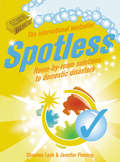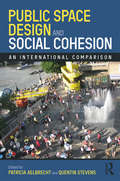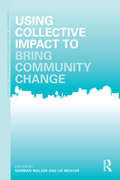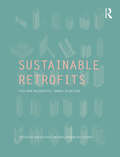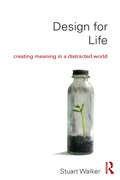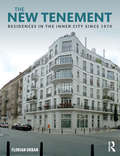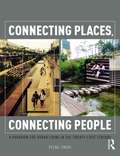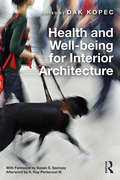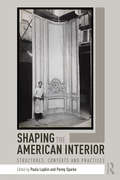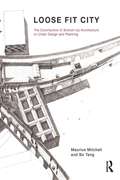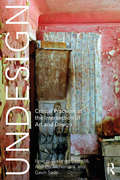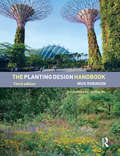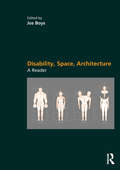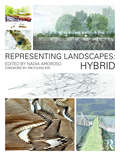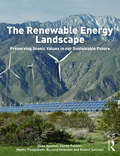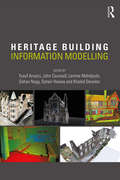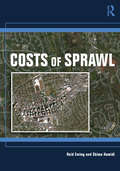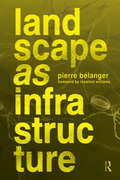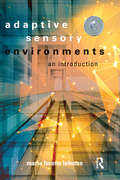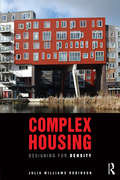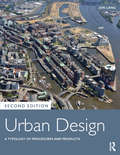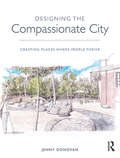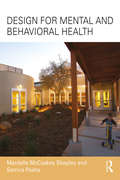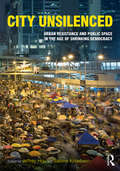- Table View
- List View
Spotless: Room-by-Room Solutions to Domestic Disasters
by Shannon Lush Jennifer FlemingIn a handy and easy to use format Spotless provides encylcopediac answers to all kinds of domestic disasters - from how to repair scratches to removing stains and other disfigurements. An essential book for the kitchen bookshelf, each chapter addresses the stains, cleaning and household problems that may come about in each room of the house: the kitchen, laundry, bathroom, bedroom, children's room and even outdoors on a deck or patio. Filled with easy, do-it-yourself cleaning solutions, handy hints and examples Spotless is a domestic bible that will be referred to again and again.
Public Space Design and Social Cohesion: An International Comparison
by Patricia Aelbrecht Quentin StevensSocial cohesion is often perceived as being under threat from the increasing cultural and economic differences in contemporary cities and the increasing intensity of urban life. Public space, in its role as the main stage for social interactions between strangers, clearly plays a role in facilitating or limiting opportunities for social cohesion. But what exactly is social cohesion, how is it experienced in the public realm, and what role can the design of city spaces have in supporting or promoting it? There are significant knowledge gaps between the social sciences and design disciplines and between academia and practice, and thus a dispersed knowledge base that currently lacks nuanced insight into how urban design contributes to social integration or segregation. This book brings together scholarly knowledge at the intersection of public space design and social cohesion. It is based on original scholarly research and a depth of urban design practice, and analyses case studies from a variety of cities and cultures across the Global North and Global South. Its interdisciplinary, cross-cultural analysis will be of interest to academics, students, policymakers and practitioners engaged with a range of subject areas, including urban design, urban planning, architecture, landscape, cultural studies, human geography, social policy, sociology and anthropology. It will also have significant appeal to a wider non-academic readership, given its topical subject matter.
Riverine: Architecture and Rivers
by Gerald Adler Manolo GuerciRiverscapes are the main arteries of the world’s largest cities, and have, for millennia, been the lifeblood of the urban communities that have developed around them. These human settlements – given life through the space of the local waterscape – soon developed into ritualised spaces that sought to harness the dynamism of the watercourse and create the local architectural landscape. Theorised via a sophisticated understanding of history, space, culture, and ecology, this collection of wonderful and deliberately wide-ranging case studies, from Early Modern Italy to the contemporary Bengal Delta, investigates the culture of human interaction with rivers and the nature of urban topography. Riverine explores the ways in which architecture and urban planning have imbued cultural landscapes with ritual and structural meaning.
Using Collective Impact to Bring Community Change (Community Development Research and Practice Series)
by Norman Walzer Liz WeaverCollective Impact as a tool to bring about community change has seen remarkable growth in usage since 2011. Collective Impact has been used successfully with a variety of local issues and has raised the consciousness of how community groups interact as well as the approaches that can lead to long-term innovations. This edited volume sets forth conceptual foundations for using Collective Impact as well as sharing basic approaches that have succeeded in projects under diverse circumstances. It will be useful for both academics and practitioners as Collective Impact continues to undergo substantial changes in focus and direction. Building on Kania and Kramer’s influential work, it provides readers with detailed insights not only into how the Collective Impact system works but also innovative applications to issues facing community developers. The diverse topics shared by the contributing authors make this volume especially important for practitioners designing programs to bring about long-term changes in their communities. Including discussion about how Collective Impact has succeeded in different governmental settings, this book demonstrates how Collective Impact has been modified to accommodate the associated cultural differences with 10 chapters written by experienced on-the-ground community development experts.
Sustainable Retrofits: Post War Residential Towers in Britain
by Asterios Agkathidis Rosa Urbano GutiérrezPresenting the state-of-the-art in sustainable retrofits in post war residential towers, this book captures and re-informs the current intense refurbishing process that is taking place in Britain, which is part of a global phenomenon happening all over the world, as cities upgrade their building stock in an attempt to comply with governmental emission reduction targets. The authors present inspections of 20 sustainably retrofitted social housing towers, analysing their aesthetic and technical modifications, as well as the shifts occurring in their social structure. The authors use over 200 full colour plans, elevations, photographs, maps and illustrations to beautifully support the statistical and analytical information collected. Finally they include interviews with some of the architects who designed the retrofits, residents and key stakeholders to inform the conclusions.
Design for Life: Creating Meaning in a Distracted World
by Stuart WalkerStuart Walker’s design work has been described as life-changing, inspiring, disturbing and ferocious. Drawing on an extraordinarily diverse range of sources and informed by creative practice, Design for Life penetrates to the heart of modern culture and the malaise that underlies today’s moral and environmental crises. The author argues that this malaise is deep-seated and fundamental to the modern outlook. He shows how our preoccupation with technological progress, growth and the future has produced a constricted view of life – one that is both destructive and self-reinforcing. Based on over twenty-five years of scholarship and creative practice, he demonstrates the vital importance of solitude, contemplation, inner growth and the present moment in developing a different course – one that looks squarely at our current, precarious situation while offering a positive, hopeful way forward – a way that is compassionate, context-based, human scale, ethically motivated and critically creative. Design for Life is an intensely original contribution that will be essential reading for design practitioners and students. Written in a clear, accessible style, it will also appeal to a broader readership, especially anyone who is concerned with contemporary society’s rising inequalities and environmental failings and is looking for a more constructive, balanced and thoughtful direction.
The New Tenement: Residences in the Inner City Since 1970
by Florian UrbanThis book examines "new tenements"—dense, medium-rise, multi-storey residences that have been the backbone of European inner-city regeneration since the 1970s and came with a new positive view on urban living. Focusing principally on Berlin, Copenhagen, Glasgow, Rotterdam, and Vienna, it relates architectural design to an evolving intellectual framework that mixed anti-modernist criticism with nostalgic images and strategic goals, and absorbed ideas about the city as a generator of creativity, locale of democratic debate, and object of personal identification.This book analyses new tenements in the context of the post-functionalist city and its mixed-use neighbourhoods, redeveloped industrial sites and regenerated waterfronts. It demonstrates that these buildings are both generators and outcome of an urban environment characterised by information exchange rather than industrial production, individual expression rather than mass culture, visible history rather than comprehensive renewal, and conspicuous difference rather than egalitarianism. It also shows that new tenements evolved under a welfare state that all over Europe has come under pressure, but still to a certain degree balances and controls heterogeneity and economic disparities.
Connecting Places, Connecting People: A Paradigm for Urban Living in the 21st Century
by Reena TiwariWhat is a better community? How can we reconfigure places and transport networks to create environmentally friendly, economically sound, and socially just communities? How can we meet the challenges of growing pollution, depleting fossil fuels, rising gasoline prices, traffic congestion, traffic fatalities, increased prevalence of obesity, and lack of social inclusion? The era of car-based planning has led to the disconnection of people and place in developed countries, and is rapidly doing so in the developing countries of the Global South. The unfolding mega-trend in technological innovation, while adding new patterns of future living and mobility in the cities, will question the relevance of face-to-face connections. What will be the ‘glue’ that holds communities together in the future? To build better communities and to build better cities, we need to reconnect people and places. Connecting Places, Connecting People offers a new paradigm for place making by reordering urban planning principles from prioritizing movement of vehicles to focusing on places and the people who live in them. Numerous case studies, including many from developing countries in the Global South, illustrate how this can be realized or fallen short of in practical terms. Importantly, citizens need to be engaged in policy development, to connect with each other and with government agencies. To measure the connectivity attributes of places and the success of strategies to meet the needs, an Audit Tool is offered for a continual quantitative and qualitative evaluation.
Health and Well-being for Interior Architecture
by Dak KopecWinner of the 2018 IDEC Book Award With fifteen essays by scholars and professionals, from fields such as policy and law, Health and Well-being for Interior Architecture asks readers to consider climate, geography, and culture alongside human biology, psychology, and sociology. Since designers play such a pivotal role in human interaction with interior and architectural design, this book sheds light on the importance of a designer’s attention to health and well-being while also acknowledging the ever changing built environment. Through various viewpoints, and over 30 images, this book guides designers through ways to create and develop interior designs in order to improve occupants’ health and well-being.
Shaping the American Interior: Structures, Contexts and Practices
by Paula Lupkin Penny SparkeBringing together 12 original essays, Shaping the American Interior maps out, for the first time, the development and definition of the field of interiors in the United States in the period from 1870 until 1960. Its interdisciplinary approach encompasses a broad range of people, contexts, and practices, revealing the design of the interior as a collaborative modern enterprise comprising art, design, manufacture, commerce, and identity construction. Rooted in the expansion of mass production and consumption in the last years of the nineteenth century, new and diverse structures came to define the field and provide formal and informal contexts for design work. Intertwined with, but distinct from, architecture and merchandising, interiors encompassed a diffuse range of individuals, institutions, and organizations engaged in the definition of identity, the development of expertise, and the promotion of consumption. This volume investigates the fluid pre-history of the American profession of interior design, charting attempts to commoditize taste, shape modern conceptions of gender and professionalism, define expertise and authority through principles and standards, marry art with industry and commerce, and shape mass culture in the United States.
Loose Fit City: The Contribution of Bottom-Up Architecture to Urban Design and Planning
by Maurice Mitchell Bo TangDrawn from a lifetime’s experience of shared city-making from the bottom up, within rapidly expanding urban metabolisms in Delhi, Mumbai, Agra, Kathmandu, West Africa and London, Loose Fit City is about the ways in which city residents can learn through making to engage with the dynamic process of creating their own city. It looks at the nature and processes involved in loosely fitting together elements made by different people at different scales and times, with different intentions, into a civic entity which is greater than the sum of its parts. It shows how bottom-up learning through making can create a more vibrant and democratic city than the more flattened, top-down, centrally planned, factory made version. Loose Fit City provides a new take on the subject of architecture, defined as the study and practice of fitting together physical and cultural topography. It provides a comprehensive view of how the fourth dimension of time fits loosely together with the three spatial dimensions at different scales within the human horizon, so as to layer meaning and depth within the places and metabolism of the city fabric.
Undesign: Critical Practices at the Intersection of Art and Design
by Gretchen Coombs Andrew McNamara Gavin SadeUndesign brings together leading artists, designers and theorists working at the intersection of art and design. The text focuses on design practices, and conceptual approaches, which challenge the traditional notion that design should emphasise its utility over aesthetic or other non-functional considerations. This publication brings to light emerging practices that consider the social, political and aesthetic potential of "undesigning" our complex designed world. In documenting these new developments, the book highlights the overlaps with science, engineering, biotechnology and hacktivism, which operate at the intersection of art and design.
The Planting Design Handbook
by Nick RobinsonSince the first edition was published in 1992, Nick Robinson's The Planting Design Handbook has been widely used as a definitive text on landscape architecture courses throughout the world. It remains one of the few titles written by a practicing landscape architect and educator who is also a horticulturalist and accomplished plantsman, and which deals with the application of planting design on a large scale in landscape architecture and urban design projects. The Planting Design Handbook is distinctive for its elegant integration of an ecological approach with an understanding of visual and spatial composition. It emphasizes the role of vegetation layers and designed plant communities in complex and diverse plant assemblages for all kinds of sites and uses. This expanded and comprehensively updated third edition still provides a complete examination of principles and practice of design for public, institutional and private landscapes. It takes account of developments in theory and practice, especially in the use of perennials, and reflects a variety of media and approaches current in landscape architecture and design. All chapters have been revised and re-written to ensure updated references and new references have been added. Many new photographs of planting and projects around the world have been included, with examples of current professional drawings to illustrate the design process. It is generously illustrated, including a colour section and the beautifully detailed line drawings of the Chinese architect and painter Jia-Hua Wu.
Disability, Space, Architecture: A Reader
by Jos BoysDisability, Space, Architecture: A Reader takes a groundbreaking approach to exploring the interconnections between disability, architecture and cities. The contributions come from architecture, geography, anthropology, health studies, English language and literature, rhetoric and composition, art history, disability studies and disability arts and cover personal, theoretical and innovative ideas and work. Richer approaches to disability – beyond regulation and design guidance – remain fragmented and difficult to find for architectural and built environment students, educators and professionals. By bringing together in one place some seminal texts and projects, as well as newly commissioned writings, readers can engage with disability in unexpected and exciting ways that can vibrantly inform their understandings of architecture and urban design. Most crucially, Disability, Space, Architecture: A Reader opens up not just disability but also ability – dis/ability – as a means of refusing the normalisation of only particular kinds of bodies in the design of built space. It reveals how our everyday social attitudes and practices about people, objects and spaces can be better understood through the lens of disability, and it suggests how thinking differently about dis/ability can enable innovative and new kinds of critical and creative architectural and urban design education and practice.
Representing Landscapes: Hybrid (Representing Landscapes)
by Nadia AmorosoHybrid and mixed media create a huge variety of diagramming and drawing options for landscape representation. From Photoshop mixed with digital maps, to hand drawings overlaid with photos and modelling combined with sketches, the possibilities are endless. In this book, Amoroso curates over 20 leading voices from around the world to showcase the best in contemporary hybrid design. With over 200 colour images from talented landscape architeture students, this book will explore the options, methods and choices to show the innovative approaches that are offered to students and practitioners of landscape architecture. With worked examples in the chapters and downloadable images suitable for class use, this is an essential book for visual communication and design studios.
The Renewable Energy Landscape: Preserving Scenic Values in our Sustainable Future
by Dean Apostol James Palmer Martin Pasqualetti Richard Smardon Robert SullivanWinner of the 2017 EDRA Great Places Award (Research Category) Winner of the 2017 VT ASLA Chapter Award of Excellence (Communications Category) The Renewable Energy Landscape is a definitive guide to understanding, assessing, avoiding, and minimizing scenic impacts as we transition to a more renewable energy future. It focuses attention, for the first time, on the unique challenges solar, wind, and geothermal energy will create for landscape protection, planning, design, and management. Topics addressed include: Policies aimed at managing scenic impacts from renewable energy development and their social acceptance within North America, Europe and Australia Visual characteristics of energy facilities, including the design and planning techniques for avoiding or mitigating impacts or improving visual fit Methods of assessing visual impacts or energy projects and the best practices for creating and using visual simulations Policy recommendations for political and regulatory bodies. A comprehensive and practical book, The Renewable Energy Landscape is an essential resource for those engaged in planning, designing, or regulating the impacts of these new, critical energy sources, as well as a resource for communities that may be facing the prospect of development in their local landscape.
Heritage Building Information Modelling
by Yusuf Arayici John Counsell Lamine Mahdjoubi Gehan Ahmed Nagy Soheir Hawas Khaled DweidarBuilding Information Modelling (BIM) is being debated, tested and implemented wherever you look across the built environment sector. This book is about Heritage Building Information Modelling (HBIM), which necessarily differs from the commonplace applications of BIM to new construction. Where BIM is being used, the focus is still very much on design and construction. However, its use as an operational and management tool for existing buildings, particularly heritage buildings, is lagging behind. The first of its kind, this book aims to clearly define the scope for HBIM and present cutting-edge research findings alongside international case studies, before outlining challenges for the future of HBIM research and practice. After an extensive introduction to HBIM, the core themes of the book are arranged into four parts: Restoration philosophies in practice Data capture and visualisation for maintenance and repair Building performance Stakeholder engagement This book will be a key reference for built environment practitioners, researchers, academics and students engaged in BIM, HBIM, building energy modelling, building surveying, facilities management and heritage conservation more widely.
Costs of Sprawl
by Reid Ewing Shima HamidiAcross the nation, the debate over metropolitan sprawl and its impact has become pivotal to urban planning. A decade and a half ago, Smart Growth America and the U.S. Environmental Protection Agency sought to raise the level of the debate by sponsoring groundbreaking research to quantitatively measure sprawl and its quality-of-life impacts. The resulting measures are widely used in urban research and public health. Costs of Sprawl provides a panoramic guide to urban form in America, measures sprawl for metropolitan areas, urbanized areas, and counties, and studies the relationship between sprawl and quality-of-life outcomes. From this preliminary investigation, it looks like the costs of sprawl are varied and substantial, and the alternative of compact development is far superior. An essential read for researchers, planners, urban designers, policy makers, and smart growth advocates in the U.S. and abroad, this book provides a comprehensive and detailed analysis of one of the most critical issues in planning today.
Landscape as Infrastructure: A Base Primer
by Pierre BelangerAs ecology becomes the new engineering, the projection of landscape as infrastructure—the contemporary alignment of the disciplines of landscape architecture, civil engineering, and urban planning— has become pressing. Predominant challenges facing urban regions and territories today—including shifting climates, material flows, and population mobilities, are addressed and strategized here. Responding to the under-performance of master planning and over-exertion of technological systems at the end of twentieth century, this book argues for the strategic design of "infrastructural ecologies," describing a synthetic landscape of living, biophysical systems that operate as urban infrastructures to shape and direct the future of urban economies and cultures into the 21st century. Pierre Bélanger is Associate Professor of Landscape Architecture and Co-Director of the Master in Design Studies Program at Harvard University’s Graduate School of Design. As part of the Department of Landscape Architecture and the Advansed Studies Program, Bélanger teaches and coordinates graduate courses on the convergence of ecology, infrastructure and urbanism in the interrelated fields of design, planning and engineering. Dr. Bélanger is author of the 35th edition of the Pamphlet Architecture Series from Princeton Architectural Press, GOING LIVE: from States to Systems (pa35.net), co-editor with Jennifer Sigler of the 39th issue of Harvard Design Magazine, Wet Matter, and co-author of the forthcoming volume ECOLOGIES OF POWER: Mapping Military Geographies & Logistical Landscapes of the U.S. Department of Defense. As a landscape architect and urbanist, he is the recipient of the 2008 Canada Prix de Rome in Architecture and the Curator for the Canada Pavilion ad Canadian Exhibition, "EXTRACTION," at the 2016 Venice Architecture Biennale (extraction.ca).
Adaptive Sensory Environments: An Introduction
by Maria Lorena Lehman***WINNER OF A NAUTILUS 2017 SILVER MEDAL BOOK AWARD*** Adaptive Sensory Environments: An Introduction presents a cutting-edge methodology for adaptive sensory design by fostering an inter-disciplinary approach in which aspects of neuroscience, biophilia, captology, nanotechnology, kinetics, and sensemaking all play critical roles in helping adaptive architecture "tune" to occupants. Furthermore, the book illustrates how adaptive sensory environments transform and uplift quality of life in entirely new ways, by strategically unlocking the potential that technological innovations bring. By teaching scholars, researchers, practitioners, specialists, and consultants how to design architecture that guides what emerging interactive technology can do, it allows them to see deeper into an architectural design, to extend beyond interaction and, ultimately, to build environments that adapt by changing and growing with their occupants’ immediate needs and long-term goals.
Complex Housing: Designing for Density
by Julia Williams RobinsonComplex Housing introduces an architectural type called complex housing, common to the Netherlands and found in other Northern European countries. Eight fully illustrated case studies show successful approaches to designing for density, which reflect values such as long-term planning, a right to housing, and access to light and air. The case studies demonstrate a wide range of applications including a mixture of urban and suburban sites, various numbers of dwelling units, low- to high-density approaches, different architectural styles, and organizational strategies that can be adopted in projects elsewhere. More than 350 color images.
Urban Design: A Typology of Procedures and Products
by Jon LangUrban Design: A Typology of Procedures and Products, 2nd Edition provides a comprehensive and accessible introduction to urban design, defining the field and addressing the controversies and goals of urban design. Including over 50 updated international case studies, this new edition presents a three-dimensional model with which to categorize the processes and products involved: product type, paradigm type, and procedural type. The case studies not only illuminate the typology but provide information that designers can use as precedents in their own work. Uniquely, these case study projects are framed by the design paradigm employed, categorized by procedural type instead of instrumental or land use function. The categories used here are Total Urban Design, All-of-a-piece Urban Design, Plug-in Urban Design, and Piece-by-piece Urban Design.Written for both professionals and those encountering urban design in their day-to-day life, Urban Design is an essential introduction to the field and practice, considering the future direction of the field and what can be learned from the past.
Designing the Compassionate City: Creating Places Where People Thrive
by Jenny DonovanDesigning the Compassionate City outlines an approach to urban design that is centred on an explicit recognition of the inherent dignity of all people. It suggests that whether we thrive or decline—as individuals or as a community—is dependent on our ability to fulfil the full spectrum of our needs. This book considers how our surroundings help or hinder us from meeting these needs by influencing both what we can do and what we want to do; either inspiring us to lead healthy, fulfilled lives or consigning us to diminished lives tainted by ill health and unfulfilled potential. Designing the Compassionate City looks at how those who participate in designing towns and cities can collaborate with those who live in them to create places that help people to accumulate the life lessons, experiences and achievements, as well as forge the connections to meet their needs, to thrive and to fulfil their potential. The book explores a number of inspiring case studies that have sought to meet this challenge and examines what has worked and what hasn’t. From this, some conclusions are drawn about how we can all participate in creating places that leave a lasting legacy of empowerment and commitment to nurturing one another. It is essential reading for students and practitioners designing happier, healthier places.
Design for Mental and Behavioral Health
by Mardelle McCuskey Shepley Samira PashaStudies confirm that the physical environment influences health outcomes, emotional state, preference, satisfaction and orientation, but very little research has focused on mental and behavioural health settings. This book summarizes design principles and design research for individuals who are intending to design new mental and behavioural health facilities and those wishing to evaluate the quality of their existing facilities. The authors discuss mental and behavioural health systems, design guidelines, design research and existing standards, and provide examples of best practice. As behavioural and mental health populations vary in their needs, the primary focus is limited to environments that support acute care, outpatient and emergency care, residential care, veterans, pediatric patients, and the treatment of chemical dependency.
City Unsilenced: Urban Resistance and Public Space in the Age of Shrinking Democracy
by Jeffrey Hou Sabine KnierbeinWhat do the recent urban resistance tactics around the world have in common? What are the roles of public space in these movements? What are the implications of urban resistance for the remaking of public space in the "age of shrinking democracy"? To what extent do these resistances move from anti- to alter-politics? City Unsilenced brings together a cross-disciplinary group of scholars and scholar-activists to examine the spaces, conditions, and processes in which neoliberal practices have profoundly impacted the everyday social, economic, and political life of citizens and communities around the globe. They explore the commonalities and specificities of urban resistance movements that respond to those impacts. They focus on how such movements make use of and transform the meanings and capacity of public space. They investigate their ramifications in the continued practices of renewing democracies. A broad collection of cases is presented and analyzed, including Movimento Passe Livre (Brazil), Google Bus Blockades San Francisco (USA), the Platform for Mortgage Affected People (PAH) (Spain), the Piqueteros Movement (Argentina), Umbrella Movement (Hong Kong), post-Occupy Gezi Park (Turkey), Sunflower Movement (Taiwan), Occupy Oakland (USA), Syntagma Square (Greece), Researchers for Fair Policing (New York), Urban Movement Congress (Poland), urban activism (Berlin), 1DMX (Mexico), Miyashita Park Tokyo (Japan), 15M Movement (Spain), and Train of Hope and protests against Academic Ball in Vienna (Austria). By better understanding the processes and implications of the recent urban resistances, City Unsilenced contributes to the ongoing debates concerning the role and significance of public space in the practice of lived democracy.
